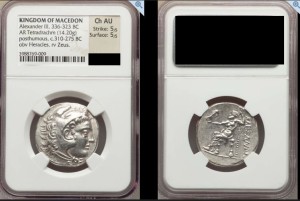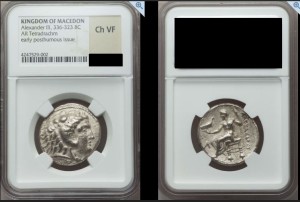2 – SITUAZIONE SINTOMATICA/ORRORE/”POSSIBILE” FALSO
Nell’attesa di un grosso articolo, che mi sta richiedendo più tempo del previsto, scrivo queste poche righe per protestare contro un malcostume (almeno a mio parere) numismatico: l'”inscatolettamento” delle monete da parte di enti certificatori. Un amico ha utilizzato in modo tragicamente assai appropriato il termine sarcofago: è la morte della numismatica. Il piacere di poter toccare con mano la storia è ciò che a molti fa spendere così tanti soldi per l’acquisto di “pezzettini di metallo con dei disegni sopra”. Per vedere una moneta dietro un vetro è molto più semplice ed economico recarsi in un museo. Ma fin qui siamo nel campo delle opinioni personali. Voglio proporre due esempi che mi permettano di fare alcune semplici riflessioni (il fatto che siano della medesima casa d’aste è una semplice casualità):
– Esempio n°1.
 http://coins.ha.com/itm/greek/ancient-coins/ancients-macedonian-kingdom-alexander-iii-the-great-336-323-bc-ar-tetradrachm-1420-gm-/a/231608-64004.s?ic4=ListView-ShortDescription-071515
http://coins.ha.com/itm/greek/ancient-coins/ancients-macedonian-kingdom-alexander-iii-the-great-336-323-bc-ar-tetradrachm-1420-gm-/a/231608-64004.s?ic4=ListView-ShortDescription-071515
– Esempio n°2.
 http://coins.ha.com/itm/greek/ancient-coins/ancients-macedonian-kingdom-alexander-iii-the-great-336-323-bc-ar-tetradrachm-no-wt-given-/a/231611-63003.s?ic4=ListView-ShortDescription-071515
http://coins.ha.com/itm/greek/ancient-coins/ancients-macedonian-kingdom-alexander-iii-the-great-336-323-bc-ar-tetradrachm-no-wt-given-/a/231611-63003.s?ic4=ListView-ShortDescription-071515
Prima alcune considerazioni generali.
La descrizione sul sarcofago è pessima, anche se alcuni elementi sono integrati dalla casa d’aste nella presentazione della moneta. Mancano dati fondamentali quali diametro e asse di conio, ma soprattutto nell’esempio n°2, cosa incredibile e inspiegabile, è assente l’indicazione del peso…visto l’inscatolettamento e la conseguente impossibilità di calcolarlo il venditore si è limitato alla laconica affermazione: “(no wt. given)”. Anche un appassionato di numismatica alle prime armi sa che il peso di una moneta è IL dato fondamentale.
Manca inoltre un qualsiasi riferimento bibliografico, (per le monete di Alessandro III è il testo del Price1) che potrebbe, forse, bastare e permettere di evitare l’indicazione della zecca e della datazione (talora presente), ma a mio avviso comunque auspicabili. E queste lacune sono in effetti colmate dalla descrizione fornita dal venditore.
Tuttavia il fatto clamoroso è costituito dall’esempio n°1.
Viene infatti indicato un peso di 14,20 g per una moneta catalogata come Strike 5/5 e Surface 5/5, ossia praticamente Mint State e anche coniata in modo perfetto.
Chiunque abbia una vaga idea della monetazione macedone sa che Alessandro Magno, a differenza di suo padre Filippo II (che per l’argento rimase fedele allo standard traco-macedone, in base al quale un tetradrammo pesa 14,50 g), adottò per i propri argenti lo standard ponderale attico, che implica tetradrammi dal peso teorico di 17,20 g, ossia 3g in più del nostro esemplare.
Quest’ultimo viene “correttamente” (almeno da un punto di vista iconografico) indicato come un Price 844. Il 4 gennaio la stessa compagnia aveva venduto un altro Price 844 dal peso corretto di 17,04 g (http://www.acsearch.info/search.html?id=2308618).
Sul sito Pella dell’American Numismatic Society, che raggruppa le collezioni della stessa ANS, del British Museum e del Münzkabinett di Berlino (http://numismatics.org/pella/id/price.844) sono attestati 6 Price 844, per un peso medio di 16,97 g, con estremi di 17,06 e 16,80 g: ben 2,77 g in più dell’esempio n°1. Mi pare proprio che il verdetto di colpevolezza per quest’ultimo possa essere emesso senza alcun tipo di ragionevole dubbio.
Appena mi sono accorto di questo orrore ho scritto alla casa d’aste per informarla della situazione. E sapete cosa è successo?
Niente di nuovo sul fronte occidentale.
Mi hanno risposto? No.
Hanno ritirato la mummia? No.
Anzi, lei e il suo sarcofago hanno fruttato ben 705 $.
Com’è possibile che un professionista venda una moneta senza fornirne il peso?
Com’è possibile poi che, pur fornendolo e vedendo che esso è completamente fuori norma, un professionista venda ugualmente una certa moneta?
Complimenti vivissimi! Ironici per ciò che concerne la parte numismatica, quantomai sinceri in relazione ai risultati economici…
2 – SYMPTOMATIC SITUATION/HORROR/”POSSIBLE” FAKE
Waiting for a big article, which is taking longer than I expected, I write these few lines to complain about a numismatic malpractice (at least in my opinion):
the slabbing of the coins by the certification bodies.
A friend used the so tragically appropriate term sarcophagus: it’s the death of numismatics. The pleasure to feel the touch of the history is what induce many people to spend so much money for the purchase of “small pieces of metal with drawings above”. To see a coin behind glass is much easier and cheaper to go to a museum. But so far we are in the field of personal opinions.
I want to propose two examples that allow me to do some simple reflections (the fact that they are of the same auction house is simply a coincidence):
– Example n°. 1.
 http://coins.ha.com/itm/greek/ancient-coins/ancients-macedonian-kingdom-alexander-iii-the-great-336-323-bc-ar-tetradrachm-1420-gm-/a/231608-64004.s?ic4=ListView-ShortDescription-071515
http://coins.ha.com/itm/greek/ancient-coins/ancients-macedonian-kingdom-alexander-iii-the-great-336-323-bc-ar-tetradrachm-1420-gm-/a/231608-64004.s?ic4=ListView-ShortDescription-071515
– Example n° 2.
 http://coins.ha.com/itm/greek/ancient-coins/ancients-macedonian-kingdom-alexander-iii-the-great-336-323-bc-ar-tetradrachm-no-wt-given-/a/231611-63003.s?ic4=ListView-ShortDescription-071515
http://coins.ha.com/itm/greek/ancient-coins/ancients-macedonian-kingdom-alexander-iii-the-great-336-323-bc-ar-tetradrachm-no-wt-given-/a/231611-63003.s?ic4=ListView-ShortDescription-071515
First some general considerations.
The description on the sarcophagus is dreadful, even if some elements are integrated by the auction house in the presentation of the coin. Fundamental data such as diameter and die axis are lacking, but especially in the example n° 2, thing that’s incredible and inexplicable, the weight is absent …
Because of the slabbing and the consequent inability to calculate it, the seller limits himself to the laconic statement: “(no wt. given)”. A numismatic novice too knows that the weight of a coin is THE fundamental fact.
Also is missing any bibliographic reference, (for the coins of Alexander III is the text of Price1) that could, perhaps, be enough and allow to avoid stating mint and dating (sometimes indicated), but in my opinion still desirable. And some of these gaps are effectively filled by the description provided by the seller.
However the sensational fact is example n°1.
A weight of 14.20 g is provided for a coin catalogued as Strike 5/5 and Surface 5/5 , ie virtually Mint State and even coined perfectly.
Anyone who has a vague inkling of the Macedonian coinage knows that Alexander the Great, unlike his father Philip II (which for silver remained loyal to the Thraco-Macedonian standard, whereby a tetradrachm weighs 14.50 g), adopted for his silver the attic weight standard, which implies tetradrachms with the theoretical weight of 17.20 g, ie 3g more of our sample.
The latter is “properly” (at least from an iconographic point of view) referred to as a Price 844. On January 4, the same company sold another Price 844 having the correct weight of 17,04 g (http: //www.acsearch .info / search.html? id = 2308618).
On the site Pella of the American Numismatic Society, which holds together the collections of the ANS, the British Museum and the Berlin Münzkabinett (http://numismatics.org/pella/id/price.844), 6 Price 844 occur, with an average weight of 16.97 g and extremes of 17,06 and 16,80 g: 2,77 g more than example n° 1. It seems to me that the guilty verdict for the latter can be reached without any kind of reasonable doubt.
As soon as I realized this horror I wrote to the auction house to inform about the situation. And do you know what happened?
All Quiet on the Western Front.
Did they answer to me? No.
Did they withdraw the mummy? No.
In fact, the mummy and her sarcophagus yielded $ 705.
How is it possible that a pro can sell a coin without giving its weight?
How is it possible that,even providing it and seeing that it is completely out of the norm, a pro can also sell a certain coin?
Congratulations! Ironic as regards the numismatic side, really honest in relation to the financial results …
1: M.J. Price, The Coinage in the Name of Alexander the Great and Philip Arrhidaeus, 2 voll., London, 1991.
Devi essere autenticato per inviare un commento.